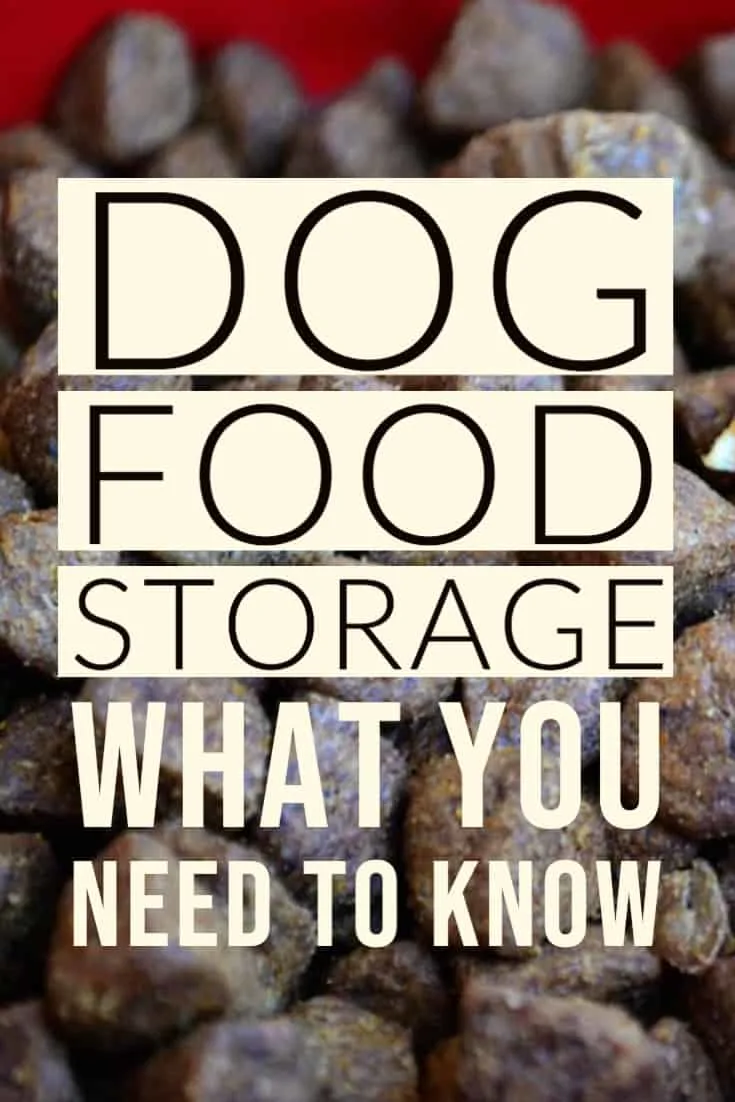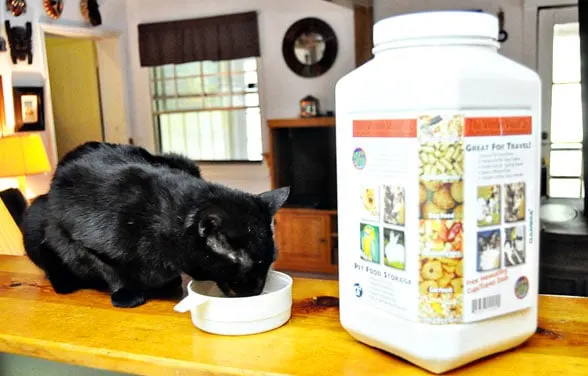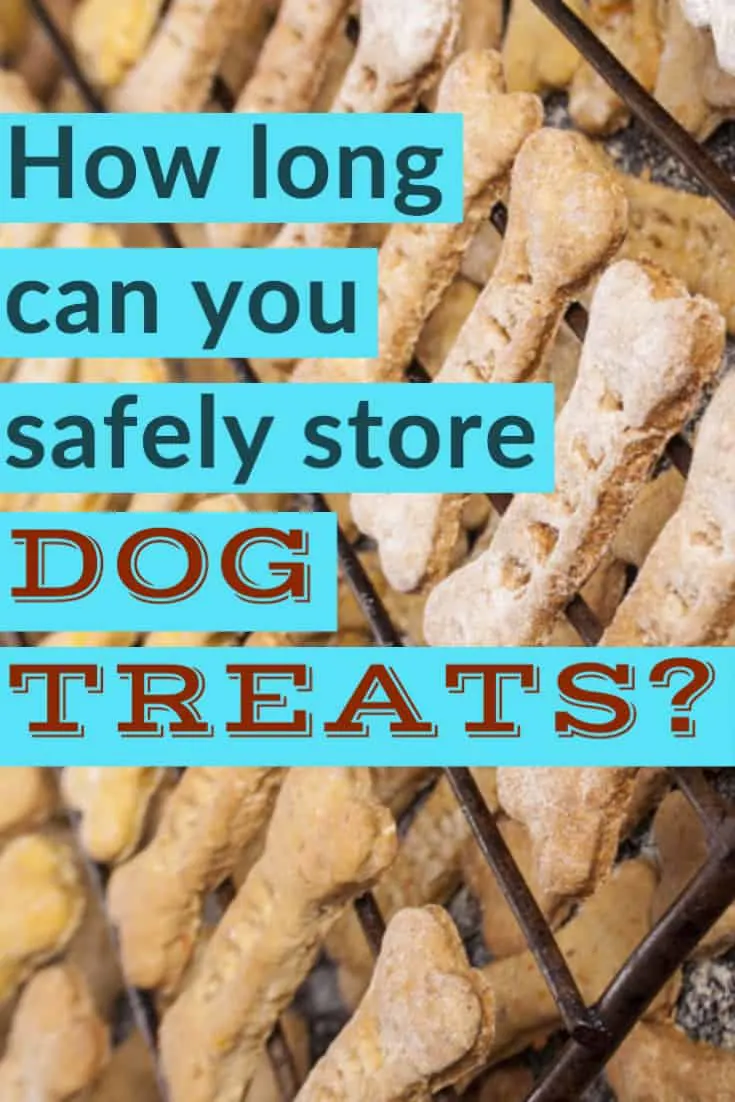Do you sometimes purchase large sacks of dog food for convenience or when they’re on sale? A large sack of dog food may last many weeks before your dog is finished with it…but how should you store it in the meantime? Let’s look at how you can safe dog food storage–and where you should NEVER store pet food!

Safe Storing Dry Dog Food
Dry dog food needs to be safe from:
- air
- water
- heat
- rodents
- ants and other insects
With these criteria in mind, your first step is to choose WHERE you want to store the dog food.
While the garage may come to mind first, it’s rarely the best place to store dog food because of potential heat problems and the greater likelihood of ants and insect infestation.
Inside your home is the best place to store dog food. Climate controlled areas are the best for keeping your pet food cool to avoid rancid dog food.
You’ll need to select an area that’s up off the floor in case of a broken water heater or other minor flood in your home. Pantry shelves can be an excellent option.
Dog Food Storage Containers
Once you’ve selected the room for your dog food, now it’s time to choose the container in which you’ll store the food.
The sack in which your dog food came is often the best way to store an unopened sack of dog food; it is specially treated to prevent oxidation–the process by which the air turns the oils in the food rancid.
An unopened bag of dog food can be stored safely in a dry, cool place until its “use by” date.
Once you have opened a sack of dog food, however, the click is ticking. You’ll need to use up that dog food within about a month of opening the sack.
You can continue to store the dog food in its original sack, rolling up the top of the bag and closing it with a chip clip to keep air and insects out of the bag. Be sure to store the bag out of your dog’s reach!
If you’d like to put the food in a dog food storage container, be sure to look for one that is specifically for food storage. Don’t use that plastic office supply bin! Dangerous chemicals can transfer from the container to your dog’s food.
When using a dog food container, be sure to start with an empty container. Don’t pour new food on top of the remains of the previous bag–that older food can very easily contaminate the new food.
Thoroughly wash–with hot water and soap–the dog food container, then dry it completely before adding food.
Can you store dry dog food in ziplock bags?
You can store dry dog food in ziplock bags if you’d like to remove it from its original packaging. I sometimes do this with larger bags so that we have smaller bags to handle on a daily basis.
You can also freeze dry dog food in ziplock bags (see below) for longer storage.
Freezing Dry Dog Food
Is the sack too large for you to use in that one-month time period?
Consider decanting the dog food into zippered plastic bags, squeezing out extra air, then freezing the food for later use.
If you have a vacuum sealer, that’s an ever better option for getting all the air out of the food package before freezing.
If you do decant your food into another bag, be sure to cut off the dog food label including the batch and lot number. Drop it into the bag with the dog food. In the event of a dog food recall, you will need this information!
Our Favorite Dog Food Storage Container

Although most dry pet foods come in “resealable” packaging to keep them fresh after they are opened, we usually prefer to decant our pets’ food into rigid containers whenever possible. We find that this method makes feeding time more convenient as we can keep a supply of our dog and cat foods in the kitchen.
We’ve tried various storage solutions for pet foods: Mason jars, general purpose plastic containers, even Paris’ collection of dog-themed cookie jars, but each of these have their own problems.
Glass jars are fragile and are limited to a few sizes, non food-grade plastic can leach hazardous substances into the food and although the cookie jars are cute, most of them are not truly air tight so the food doesn’t stay fresh for long. And, even the best resealable bag can leak air and invite ants.
Gamma² makes an extensive range of rugged Vittles Vault plastic containers which are purpose-built to keep pet foods factory-fresh and easily accessible. The company has several Vittles Vault dog food storage containers including:
- Vittles Vault Prime with capacities ranging from 20 gallons down to 2 gallons
- Vittles Vault Stackables, squarish containers designed to save space in the pantry
- Vittles Vault Select, clear storage bins with air-tight lids
- Vittles Vault Choice which includes both rigid and soft-sided storage bins.
Vittles Vault containers are made of food-grade, FDA approved high-density polyethylene which is BPA-free. (BPA, Bisphenol A, is a chemical which has been linked to health concerns.)
They are air-tight and pest-proof, with patented large screw-in lids and FDA-grade styrene butadiene rubber gaskets.
As noted above, Vittles Vaults are available in a range of sizes to accommodate any food storage situation from the large 20-gallon size which will hold about 80 pounds of food to the Vittles Vault Jr. (holding 1.3 gallons; 5 pounds of food) which is designed for travel or for counter-top or refrigerator storage.
The containers are in a neutral, grayish color and have rounded edges which are specially designed to confound chewing pests like mice and rats.
Products are made in Gamma2’s facilities in California and Tennessee.
The Vittles Vault Jr. we use comes with a double lid; an inner screw lid and an outer pop-off top which can serve as a measuring cup or as a travel dish. The squarish container measures 10-1/2 inches tall by 5-1/2 inches wide and has a molded handle built into one corner.
We think the Vittles Vault Jr. is a well-built, safe product which will be the perfect storage solution for our pet foods. (The cookie jars will have to go back to the display shelf!) A big paws up for Gamma2’s Vittles Vault Jr.!
Store Dog Treats

Unlike dog food, dog treats are generally sold in small bags–but if you want to stock up, you’ll need to safely store them as well. We’ve got an entire post on how to safely store dog treats, both commercial and homemade!
How to Store Natural Dog Food
And if you’ve purchased natural dog food, does that make a difference?
We interviewed Dr. Marcie Campion, a pet nutritionist and scientific relations manager for Iams/P&G Pet Care, about the best way to store your large sacks of natural dog food without artificial preservatives. We wondered if this impacted the storage of large bags of the food.
“Natural dog foods are preserved with natural preservatives, in this case, vitamin E, rosemary, and citric acid,” said Dr. Campion. “When you put that combination together, that is the preservative we use in Iams Naturals. Our products have a 16-month shelf life so you have plenty of time.
“You can store it like a traditional dog food but, like with any of your food products, you want to keep it in a cool place. Typically room temperature is what we think about because if you have it in a hot, humid place, the preservative won’t be as effective long term. It’s like any other foodstuff, human or pet: you want to make sure you store it in a cool, dry place.”
You don’t have to worry about putting the package in a dark place if it’s stored in the bag. However, according to Dr. Campion, “a lot of times we find our consumers opening up the package and putting it into something else that’s resealable like Tupperware or something like that. If your Tupperware container is clear, you wouldn’t want to leave that sitting in the window in sunlight.”
More Posts You Might Like
How Long Can You Store Dog Treats
- Taking Your Dog to See Santa: Tips for a Jolly Visit! - December 7, 2023
- The Pug Dog Price Tag: What You Need to Know Before You Get Your Pug - September 7, 2022
- National Microchipping Month {How it might save your dog’s life} - May 23, 2022
